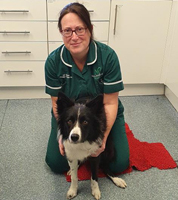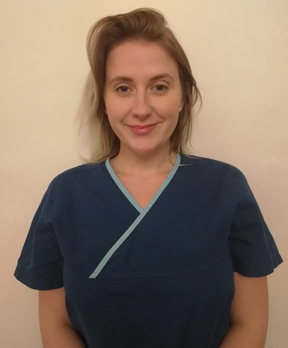
Dot Creighton 288

Photo courtesy of Dot Creighton
A former president of the British Veterinary Nursing Association, Dot Creighton advocates broadly expanding the role of and opportunities for veterinary nurses. She's pictured with Gin, who belongs to a member of the team at the clinic where Creighton works.
Veterinary nurses in the United Kingdom soon could be performing cat castrations as part of a historic expansion of their duties that some hope could catch on overseas, including in North America.
Proposed changes to British legislation also would allow veterinary nurses — a position broadly equivalent to technicians in the United States — to "play a greater role" in anesthesia and prescribe some medications; precisely which medications has yet to be determined.
In addition, the term "veterinary nurse" would be given statutory protection to prevent unqualified individuals from adopting the term and to bolster the reputations of people holding recognized veterinary nursing degrees.
The possible updates to Britain's Veterinary Surgeons Act are among recommendations by a working group that was formed in 2017 by the Royal College of Veterinary Surgeons, the profession's regulatory body in the U.K.
The working group, which includes veterinarians, veterinary nurses and laypeople, was tasked with finding ways of modernizing the profession and making regulations more efficient.
Its recommendations have been received by the RCVS's governing council, which will decide whether to formally approve them following a public comment period that is expected to close by year's end. Any approved reforms would then be recommended to the U.K. government, which would have to prepare new legislation and allocate time for a parliamentary vote.
Whether to expand the role of nurses and technicians has been a subject of debate in the veterinary profession globally for decades. On the one hand, many in the nursing or technical realms want greater recognition of capabilities developed through years-long college degrees and practical experience. On the other hand, some in the veterinary realm may believe that work will be taken away from veterinarians, or that animal welfare will suffer if people with less training are delegated more sophisticated tasks.
The proposed reforms in Britain would strictly limit change to three measures: It would allow nurses to perform castration in cats; take a greater role in anesthesia; and prescribe "certain routine" medications.
Representatives of the British Veterinary Association, the U.K.'s chief advocacy group for veterinarians, were part of the working group and have signed off on the proposed changes.
"Veterinary nurses are highly trained and underpinned by strong regulation," RCVS director of communications Ian Holloway told the VIN News Service. Holloway called the Veterinary Surgeons Act "outdated" and overly restrictive in delegating tasks to them. "The legislation working party believes that veterinary nurses are more than capable of expanding their roles and that the RCVS should have flexible powers to allow delegation to veterinary nurses where the evidence shows no significant risk to animal health and welfare," he said.
Is a cat's scrotum a body cavity? And does that even matter?
Being allowed to perform cat castrations would come as an especially big relief to Britain’s veterinary nursing community, which has been calling for that particular change for decades.
Veterinary nurses in the U.K. at one time were allowed to neuter male cats, a relatively simple procedure that involves administering anesthesia and making a small incision, to remove the testicles, that doesn't require stitches.
But that ended in 1988, when the Veterinary Practices Act was amended to prohibit "untrained laypeople," including farmers, from carrying out numerous procedures, with the intent of protecting animal welfare.
Three years later, in 1991, the Veterinary Practices Act was updated to formally recognize the role of veterinary nurses and allow them to undertake minor acts of surgery, such as stitching wounds. Cat castrations, however, were still out of bounds, partly because the legislation stated, and still states today, that non-veterinarians can't perform procedures involving "entry into a body cavity."
In 1998, after much debate, the RCVS clarified that the scrotum of a cat is a body cavity, disappointing nursing advocacy groups, including the British Veterinary Nursing Association (BVNA).
Today's RCVS-appointed working group has accepted that times have changed. "Veterinary nurses are now a fully-fledged allied profession, associates of, and regulated by, the RCVS under its Royal Charter powers," the group said. "They are not the 'laypeople' targeted in 1988." The working group made its recommendation, it added, "notwithstanding the debatable question of whether castration is 'entry into a body cavity.' "
By contrast, castrating dogs and spaying dogs and cats remain strictly in veterinarians' hands. Spay procedures are more invasive, while castrating dogs is considered more complicated owing to differences in anatomy and, in most cases, the animal's larger size.
'It opens doors, and the scope is huge'
Chloe Fay 288

Photo courtesy of Chloe Fay
Veterinary nurse Chloe Fay believes delegating more duties to nurses would enhance practice efficiency, benefiting everyone.
Not surprisingly, the BVNA is jubilant about the prospect of reform. Jo Oakden, a veterinary nurse working in Leicester, England, and the association's junior vice president, told VIN News: "We recognize this as a major step in the right direction for registered veterinary nurse recognition; it opens doors, and the scope is huge."
Her colleagues agree. "They’re good changes, and I think they’ve been a long time coming, to be honest, especially in the role of anesthesia," said Chloe Fay, a 29-year-old veterinary nurse who works at New Priory Vets in Brighton, England.
All too often, Fay said, animals are kept under anesthesia for longer than necessary because veterinarians get waylaid in the practice and the veterinary nurse is powerless to act. Time is often wasted at the start of the process, too, Fay added. "If nurses can be inducing anesthesia and getting patients ready for surgery instead of having to hang around waiting for the veterinarian, it just reduces that waiting time for everyone," she said. "It will increase revenue and also reduce the time for patients being sat around stressing in kennels."
Currently, veterinary nurses in the U.K. are limited to maintaining, monitoring and inducing anesthesia using a specific quantity of medicine directed by a veterinarian. The working group's proposed changes would allow nurses to "assist in all aspects of anesthesia under supervision" in order to increase nurse utilization and free veterinarians' time.
Other changes could help practices function more efficiently overall, Fay said. "Cat castration is such an easy thing for nurses to do, and it's also a confidence booster for them because they would feel more involved."
On prescribing, Fay suggests nurses could take care of doling out repeat prescriptions, or initial prescriptions of dewormers or flea control. "I think it builds more of a team atmosphere where everyone’s empowered to work together," she said, "rather than just being led by the vet."
Dot Creighton, a 48-year-old veterinary nurse who works at the Millennium Veterinary Practice in Essex, England, and has been practicing for 30 years, said she is "all for" enhancing the veterinary nurse role. "But I feel there is so much more to expanding our role than just 'taking on' some of the tasks and procedures that a vet does," she told VIN News.
Creighton said registered veterinary nurses in the U.K. already have plenty to do. On a typical day, Creighton said she might have three patients that need medicines every 12 hours, or patients that need tube feeding five times a day. Other common duties, she said, include wound checks and redressing, managing blood glucose curves and blood pressure, administering eye drops or providing palliative care.
"There is always scope for registered veterinary nurses to do more, but in my view, we are taking a backward step if we are going to focus only on 'vet' procedures," she said. As an example of the more expansive opportunities she seeks, Creighton is an advocate of the so-called district veterinary nurse role, which involves nurses visiting people's homes to help them care for their pets.
Time for a pay increase?
The average annual salary for veterinary nurses in the U.K. ranges from £18,000 to £26,000 (US$24,000 to US$34,000), according to the government. That’s a little more than half the average veterinarian salary, which the government says is between £30,000 and £50,000 (US$39,000 to US$65,000).
In the U.S., the gap is even larger. According to the U.S. Bureau of Labor Statistics, the mean annual wage for veterinary technicians last year was barely 35% of the mean annual wage for veterinarians: US$36,670, compared with US$104,820.
If veterinary nurses or technicians start performing jobs such as cat castrations, Fay and Creighton say, they should get paid more. "I think the veterinary nursing profession as a whole is underpaid and undervalued already," Fay said. "If you bring in these changes and nothing else happens, it would mean that veterinary nurses are essentially going to be even more undervalued."
That wouldn't necessarily mean that veterinary nurses would need a bigger slice of the practice's revenue pie. If expanding the role of nurses made practices more efficient, the businesses might be able to afford paying everyone more. "Registered veterinary nurses are revenue generators, after all," Creighton said.
At the same time, they might want to brush up on their skills, to reassure veterinarians that they're up to new tasks.
To become a veterinary nurse registered with the RCVS, individuals must hold an approved educational qualification or have passed an exam formally administered by the RCVS. They also must have completed 1,800 hours of practical training. Becoming a veterinarian, by comparison, requires completing a five-year undergraduate degree in veterinary medicine.
The BVNA's Oakden said some of the proposed new duties are within the existing skill sets of some veterinary nurses. She acknowledged that allowing nurses to prescribe medicines would require additional education and training. "[Prescribing medicines] is such a vast area and is still a proposal very much in its infancy," she said.
Fay would like to see the U.K. take a leaf out of America's book and recognize the veterinary technician specialist (VTS) designation. Fay herself has VTS status for emergency and critical care. (The program is available internationally.) "You have to have mastered the skills to earn the designation. It's not just a case of doing it once," she said. "And that really installs some confidence, in vets in particular, but also in the general public."
American veterinary technicians watch with interest
The progress of the U.K. recommendations is being watched closely overseas, including by the National Association of Veterinary Technicians (NAVTA) in the U.S. Technicians there can induce and monitor anesthesia under the supervision of a veterinarian. However, the two other proposed changes in Britain — allowing cat castrations and prescribing medicines — are not permitted in the U.S., nor in other developed countries, including Canada and Australia. In the U.S., for instance, castrating a cat is considered an act of surgery, which is restricted in every state to licensed veterinarians, as are acts of prognosis, diagnosis and prescription.
Still, NAVTA President Kenichiro Yagi is hopeful that any changes in Britain could ripple across the Atlantic. “Seeing the U.K. looking into expanding the role of the veterinary nurse really is exciting to me,” Yagi, a veterinary technician with 20 years of experience, said in an interview.
NAVTA, too, long has been attempting to lift the standing of U.S. veterinary technicians, including via its Veterinary Nurse Initiative, which, as the name suggests, supports the adoption of the “veterinary nurse" title across all 50 states, as well as standardizing qualifications and scope of practice. The effort is not without challenges, including overcoming some state legislatures that define "nurse" as strictly applying to human medicine.
Yagi would like to see things go further than Britain's proposal. He is among advocates of creating an advanced role similar to physician’s assistants or nurse practitioners in human medicine. For those roles, individuals obtain a master's level education and are licensed to practice medicine. They can perform physical examinations, diagnose and treat illnesses, order and interpret tests, counsel on preventive health care, assist in surgery and write prescriptions. Nurse practitioners are allowed to practice human medicine autonomously in most U.S. states, while physician's assistants practice under the physician’s license.
Yagi posits that adopting similar roles in veterinary medicine could improve access to care by alleviating veterinarian shortages, whether nationally or in rural areas, and easing the stress burden on overworked practitioners. For veterinary technicians, Yagi said the career option could help alleviate "pain points" driving a workforce shortage, including low wages, a perceived lack of respect and being underused despite years of college study.
Some U.S. states allow veterinary technicians to perform dental extractions, although not without controversy. The American College of Veterinary Dentistry is opposed to veterinary technicians performing such work, as is the Academy of Veterinary Dental Technicians.
Recent events in Colorado indicate that establishing a mid-tier professional role isn't easy. A move by Colorado State University in 2015 to introduce a Masters of Science Veterinary Professional Associate program was aborted after encountering resistance from veterinarians. Of 238 practitioners who responded to a Colorado Veterinary Medical Association survey about the program, 50% didn't think it would "help at all" with problems facing small animal practices, while 23% thought it would "help only minimally." Some 52% said it was "very likely" the proposed program would take jobs away from early-career veterinarians, while 34% thought that was "somewhat likely."
The idea of a mid-tier role drew a mix of reactions from veterinary nurse co-workers whom Creighton queried at Millennium Vets. Two suggested they'd like to perform the equivalent of a nurse practitioner role in human medicine. One did not: "I personally wouldn't want any more responsibility than we already have!" the colleague said.
As for the more modest changes being proposed in Britain, Fay says veterinarians shouldn't be alarmed. "There will always be people that will see changes like this as us treading on their toes — and I do get where they’re coming from,” she said. “Vets go to school for a longer time and they go through more intensive training, but I think these changes would only be a good thing."
As she sees it, the changes will free veterinarians to perform more intricate and time-consuming clinical cases, rather than laboring over repeat prescriptions and cat castrations. "Not that those things are boring,” she added. “But they’re things that nurses could be doing and are skilled enough to do so the whole team can make better use of their time."